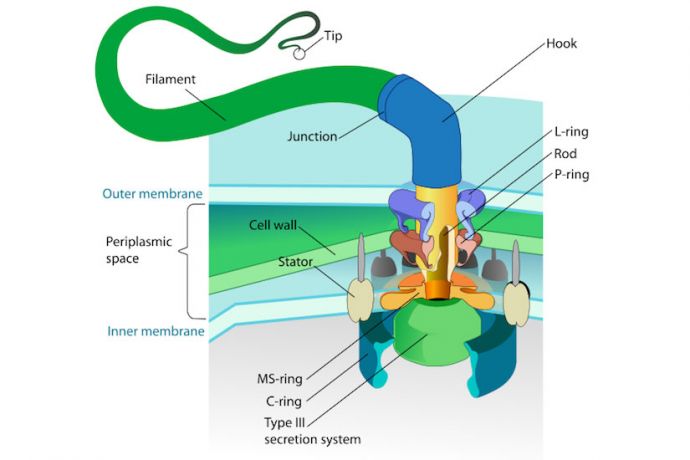Studying this amazing machine may give you a different perspective on what some consider simple organisms. Its incredible complexity defies evolution!

The complexity of the bacterial flagellum defies evolution!
There is an amazing, little rotary engine that is in use trillions upon trillions of times every day that provides irrefutable evidence that there is a Creator. Like an outboard motor, this engine has a propeller, stator, motor, universal joint, driveshaft and bushings, and is perhaps one of the most energy-efficient machines in the world. The propeller operates at between 6,000 and 100,000 revolutions per minute and can completely reverse its direction within a quarter turn of its body.
You might guess that it is a machine used in heavy industry. But without an electron microscope, you cannot even see this incredible piece of machinery. Called a flagellum, it is the “motor” that propels bacteria.
Bacteria are essential to life. They aid in digestion and fight other, bad bacteria. Good bacteria cause milk to become yogurt, cucumbers to become pickles, apples to become vinegar, grapes to become wine and cabbage to become sauerkraut. The bacteria in these fermented foods are beneficial to our health.
Irreducibly complex
A flagellum helps a bacterium move through liquids. It is composed of 30 to 40 working parts and makes up a system Michael Behe, professor of biochemistry at Lehigh University, calls irreducibly complex—meaning that no part of the machine is of any value without the other parts.
This is a big problem for evolutionists because any one part of an organism like this would not and could not have evolved “over time.” All must be present in order to function; and without even one small part, the flagellum would be useless.
Evolution teaches that bacteria were one of the first life-forms to evolve, but most bacteria could not survive without this incredible “outboard motor” of the flagellum.
When Darwin proposed the theory of evolution, he did not have access to an electron microscope and hence believed a single cell was the smallest and simplest component of living creatures. We now know that living cells contain a host of specialized machinery to keep the cell healthy, repaired and reproducing. The documentary “The Hidden Life of the Cell” by the BBC states that there are at least a billion little machines in each of the 120 trillion cells that make up a human being!
While the single-celled bacterium is not as complex as other living things, it is not just a blob as Darwin thought. The “motor” part of a bacterium—the flagellum—is extremely complex. It is so amazing that New Scientist magazine calls it “a prime example of a complex molecular system—an intricate nanomachine beyond the craft of any human engineer” (Dan Jones, “Uncovering the Evolution of the Bacterial Flagellum,” Feb. 16, 2008, emphasis added). And yet it is so tiny that 8 million of them would easily fit on the cut end of a piece of human hair!
But, as they say in the vernacular, you ain’t heard nothin’ yet! One of the most incredible aspects of this machinery is that it builds and repairs itself! It takes about 20 minutes for a new machine to be constructed, one part at a time, from the inside out. And each construction has several checks and balances that abort production if any part is not formed perfectly, thus saving energy and resources.
Scott Minnich and Stephen Meyer say this about the flagellum of the E. coli bacteria:
“The flagellum is a true nanomachine of remarkable complexity in structure and assembly control. This macromolecular machine self-assembles and repairs, displays assembly control and processing, operates with two gears, is fueled by proton motive force, and the apparatus is ‘hard-wired’ to a sensory apparatus that functions on short-term memory (chemotaxis). Rotor speeds for E. coli are estimated at 17,000 rpm but motors of some marine vibrios have been clocked upward of 100,000 rpm” (William Dembski, ed., Darwin’s Nemesis, 2006, p. 215).
Without excuse
How can anyone who honestly studies living cells doubt that a superior intelligence created them? Even if evolutionists could explain the irreducibly complex mechanics of a system like the flagellum (and they do try!), they cannot account for the intelligence inside it. What tells the flagellum to rotate its powerful “tail,” and who tells it where to go and what to do? Who tells it how to build or repair itself and abort production if something goes wrong?
Biochemists, engineers and scientists in every field have come to see that the premise behind Darwinism—that life is a result of blind chance and mindless, undirected evolution—is not supportable and that the only reasonable explanation for life is intelligent design. Of course, most of these brilliant scientists do not accept the fact that the Designer they are describing is the God of this universe.
As the apostle Paul says of them:
“For since the creation of the world His invisible attributes are clearly seen, being understood by the things that are made, even His eternal power and Godhead, so that they are without excuse, because, although they knew God, they did not glorify Him as God, nor were thankful, but became futile in their thoughts, and their foolish hearts were darkened. Professing to be wise, they became fools” (Romans 1:20-22).
Inside each cell in our body there is a microcosmic universe of such complex engineering magnificence that it virtually defies the imagination. Even so, without the single-celled organisms, bacteria, we could not survive. The whole incredible system constitutes proof of a Creator.
Fearfully and wonderfully made
Centuries ago, King David pondered the creation and concluded this about the existence of God:
“I am fearfully and wonderfully made; marvelous are Your works, and that my soul knows very well” (Psalm 139:14).
For other examples of irreducible complexity that defy Darwinian evolution, see the article “Irreducible Complexity.”




